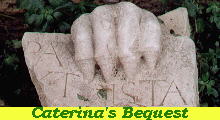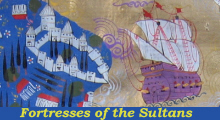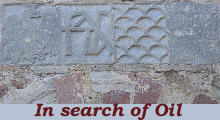

What's New!
Detailed Sitemap
All images © by Roberto Piperno, owner of the domain. Write to romapip@quipo.it. Text edited by Rosamie Moore.
Page revised in February 2013.
|

 Part six - Cirenes Part six - Cirenes
(detail of a Venetian Winged Lion in the fortifications of Famagusta)
If you came to this page directly, you might wish to read a page with an introduction to this section first.
Eastern view of the fortress and the ancient harbour of the town
Cerines (today's Kyrenia/Girne) is situated on the northern coast of Cyprus; it is not very far from Famagusta as the crow flies, but between the two ports there is the so-called "pan handle", the Karpas Peninsula which stretches for fifty miles in a north-eastern direction.
During the Franco-Venetian rule of the island (1192-1571) while Famagusta was perfectly located for ships sailing eastwards to Laiazzo, Tortosa and Tyre, Cerines and nearby Lapithos were the ports of Cyprus for ships coming from Candia (Crete), a Venetian possession, and Rhodes.
The fortress: (left) Lusignan Tower; (right) south-eastern bastion (on the side of the ancient harbour)
The fortress is clearly made up of two different parts; the old one was built by the Lusignan Kings of Cyprus who enlarged an existing Byzantine castle. It retains the embrasures from which archers threw arrows on the assailants and it is located nearer to the ancient harbour (to its east) than to the medieval one (to its west).
The Venetians built two circular bastions at the ends of the medieval section. They projected from the walls so that cannon on their battlements could fire on the enemy from a flanking position. The Venetians enlarged the fortress on its western side by incorporating parts of the medieval town.
Tower of the Chain and above it the Castle of St. Hilarion
A tower stood at the opposite end of the harbour; in case of danger a chain between the fortress and the tower was raised to block hostile ships. This mean of defence was commonly used by the Venetians (e.g. at Famagusta), by the Genoese (e.g. on the Bosporus), by the Ottomans (e.g. at Nauplia) and before them by the Arabs (e.g. at Mahdia) and by
the Carthaginians at Carthage.
Castle of St. Hilarion seen from Kyrenia
The ruined Castle of Hilarion is a particularly interesting and perhaps unique example of a "chateau fort " built as a royal
residence, and completely abandoned since the close of the Middle Ages. Such a monument illustrating the mode of life of medieval
royalty, untouched by subsequent alterations, would be difficult to find in Europe. Here we have the most interesting of souvenirs
of the once famous Royal House of Cyprus and Jerusalem. It is associated with the legend of a shepherd who enters a doorway and finds himself in an enchanted garden where he passes years, coming back to life at sunrise on a dewy morning. According to another legend it housed the treasury of a queen which attracted the cupidity of the ignorant peasant to the undoing of much of the old ruins.
From George Jeffery - A Description of the Historic Monuments of Cyprus - 1918.
The castle was in part dismantled by the Venetians before the 1570 Ottoman invasion of the island as they did at other locations which they were unable to defend.
Interior of the fortress
The fortress has a square shape and on one side it retains traces of the royal apartments where occasionally the Lusignans resided. A survey made by Venetian military engineers prior to the Ottoman invasion concluded that the fortress, notwithstanding its new round bastions, was not up to the standards of other Venetian fortifications and suggested it ought to be abandoned.
(left) Ancient boat; (right) ancient columns and millstones
Today the fortress houses a very interesting shipwreck of the IIIrd century BC which carried wine, olive oil and almonds. It was found in 1967 on the northern coast of the island. A series of ancient inscriptions, columns, capitals and millstones are scattered here and there in the vast courtyard, with no references to the locations where they were found.
Exhibits of the War Museum: (left) Ottoman assailant; (right) Venetian soldier and an old cannon
For a long time the fortress was used as a prison by the Ottomans and after them by the British administration.
Today the Lusignan Tower houses a small War Museum mainly consisting of dummies; among other exhibits it displays a dummy of an Ottoman soldier equipped for the final assault on a fortress. This was launched after artillery fire and sappers had damaged the walls. The success of the assault depended upon the number and nimbleness of the assailants, who were subject to extremely heavy losses.
A relief of the Lusignan period; (centre) coats of arms perhaps of the Ibelin-Lusignan: (according to local guides they were placed outside the fortress and they belonged to the Lusignan Kings of Cyprus, four of whom married ladies of the house of Ibelin; for a comparison see the coats of arms at Bellapais); (right) soldiers of King Richard I of England (who conquered Cyprus in 1191) and of Guy de Lusignan
The fortress of Cirenes was the site of a dramatic siege which lasted three years and sprang from a dynastic quarrel between Charlotte of Cyprus, wife of Louis of Savoy, Count of Geneva, and her half-brother James II.
Eventually in 1463 Charlotte was forced to flee the island and repair to Rome; in 1485, in return for a pension she ceded her rights to Charles I, Duke of Savoy; because of this when in 1861 Victor Emmanuel II of Savoy became King of Italy the official endorsement of the Italian Parliament made reference to him as King of Sardinia, Cyprus and Jerusalem.
The fortress seen from the medieval harbour
The fortress was and is extremely imposing and apparently able to withstand a long siege, however when
Lala Mustafa Pacha, the commander of the Ottoman army which invaded Cyprus in 1570, after having conquered Nicosia, turned his attention to Cerines, the Venetian commander preferred to surrender; according to some chronicles he could rely on just fifty soldiers.
(left) Round tower of the walls of the town; (right-above) top section of a tower with machicolations (openings from which stones or burning objects were dropped on attackers); (right-below) portal and wooden panel of Agia Chrysopolitissa
In the Middle Ages the town was probably rather large. Its size was reduced by the enlargement of the fortress. It was protected by walls which the Venetians did not care to modify; a massive round tower protected the south-west angle of the old town. Agia Chrysopolitissa, a now abandoned church, was built in the late XVIIIth century making use of elements of Gothic buildings.
View from the fortress
You may wish to make An Excursion to Bellapais.
See the other pages of this section:
Famagusta - The Walls
Famagusta - Main Churches
Famagusta - Other Monuments
Nicosia - Walls and Houses
Nicosia - Churches and Mosques
Larnaca

SEE THESE OTHER EXHIBITIONS (for a full list see my detailed list).
  
|